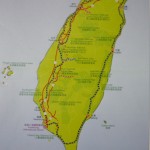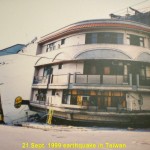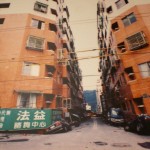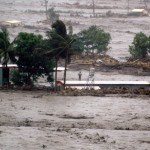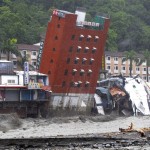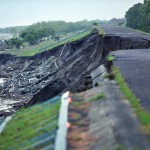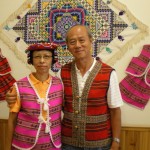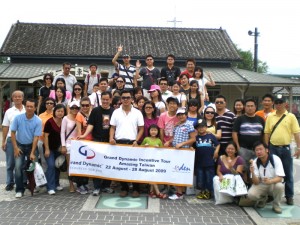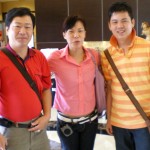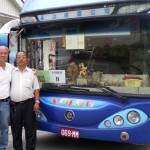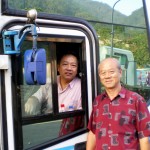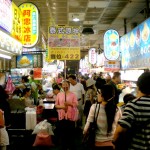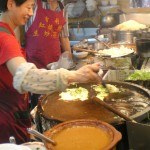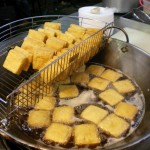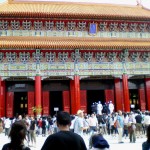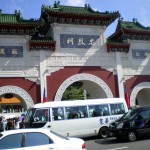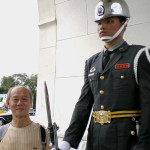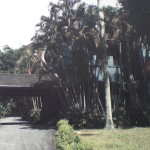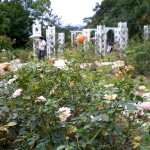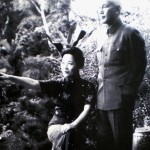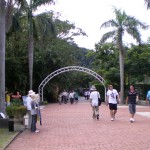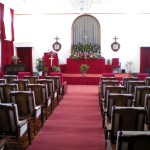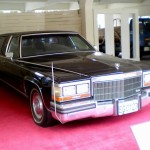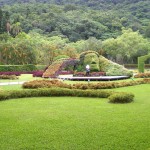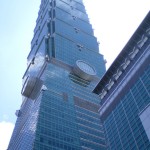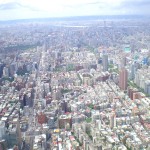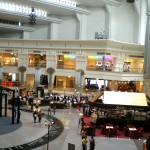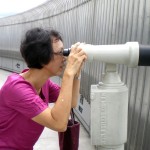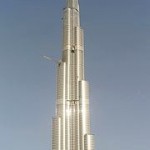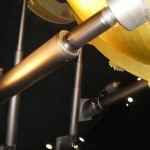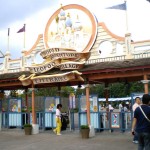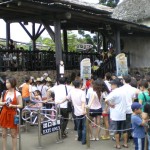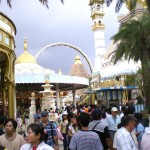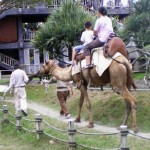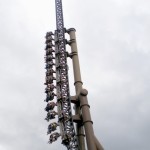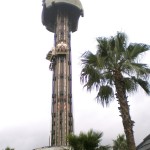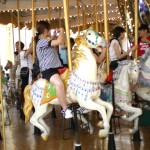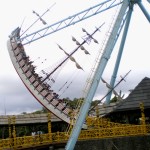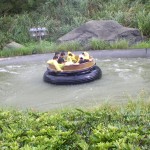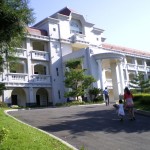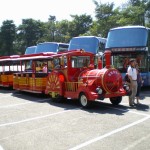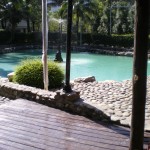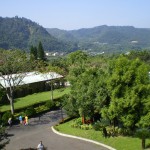Taiwan Travel I
Taiwan Travel
Location of Taiwan
Taiwan is located 120 km off the southeast coast of Mainland China. It is 394 km long and 144 km wide with an area of 35,980 sq. km. Comparatively, Taiwan’s area is about 300 times smaller than that of Mainland China. It has the shape of a sweet potato. Two thirds of the island is mountainous and the highest peak is Yu Shan or Jade Mountain(3,952 metres).
Natural Disasters
Earthquakes: As Taiwan is on the Pacific Ring of Fire it often experiences earthquakes. The last powerful and deadly earthquake of 7.3 on the Richter’s scale occured 10 years ago (21 September 1999). It destroyed over 44,000 dwellings and buildings, and caused 132 landslides resulting in over 2,400 deaths in Central Taiwan. Besides earthquakes, it also experiences another kind of natural disaster, i.e. floods and mudslides, caused by strong winds (typhoons) which bring large amount of rainfall from the Pacific Ocean. They usually occur between May and November every year.
Morakot: The last powerful typhoon, Morakot, struck Southern Taiwan on 8 August 2009 and killed several hundreds of people. It brought a record-breaking rainfall of 2,900 mm in three days causing massive floods and mudslides in many mountainous areas in southern Taiwan. The floods damaged roads and a railway, washed away several houses into the sea, toppled over a large hotel into a raging river and rose to the 2nd. floors of some buildings. The mudslides buried a few villages, e.g. Shiao Lin in Kaohsiung County where many villagers were buried alive.
History
Taiwan is ruled by the Nationalist Government (Kuomintang Government). In the beginning, the Nationalist Party under Dr. Sun Yat-sen overthrew the Qing Dynasty in 1911 in the Mainland China. Then the party resisted the Japanese aggression for 8 years from 1937 until 1945 in the Mainland China when Japan lost the World War II. Later, in 1949, the Nationalist Government under President Chiang Kai-shek was overthrown by the Communist Party under Mao Zedong. Consequently, the Nationalist Party was forced to move out of the Mainland China to Taiwan together with two million loyal people. Since the party left the Mainland China in 1949, it still clings on to the hope that one day it will rule the mainland again.
Population
The island is now populated by 23 million people. Comparatively, its population is over 60 times smaller than that of the Mainland China. 95% of the Taiwanese are Hans, 2% aborigines and the rest are other races. The common religions in Taiwan are Buddhism(35%), Taoism(33%), I-Kuan Tao(3.5%), Protestantism(2.6%), and Roman Catholicism(1.3%).
Tourist Destination
Taiwan is a beautiful island that offers lots and lots of scenic and cultural attractions. Its physical landscape of mountains, steep valleys, high cliffs, roaring streams, tranquil lakes, islets, and stunning coasts; its diverse vegetation from the tropical rainforests to alpine trees; its mixed culture of the native and Mainland Chinese; and its food of different regional culinary traditions of the Mainland China and the aborigines are some of the attractions that, undoubtedly, make it a famous tourist destination.
Day 1 : Saturday, 22 August 2009
Journey to Taiwan
On 22 August 2009, my wife and I joined a group of 49 Malaysians at the Kuala Lumpur International Airport for a seven-day vacation in Taiwan. Together with them and a tour leader, Kim Loh, we boarded a China Airlines plane and left the airport at 2.30 p.m. for Taiwan. After three hours of smooth flight, we landed safely at Taoyuan International Airport in north-western Taiwan. On arrival at the airport, our group was split into two: Group A(27 persons) and Group B(24 persons). Group A was led by a Taiwanese tour guide, Mr. Leong, whereas Group B was led by Miss Tracy Tu. My wife and I belonged to the latter group. Coming out of the airport, we boarded their respective buses, Bus A and Bus B. Then we were on our way to Taipei City.
Taipei City, the Capital of Taiwan
Taipei City was made the Taiwan’s capital by the Nationalist Party since 1949, when it was ousted by the Communist Party from the Mainland China. Taipei is the largest city in Taiwan. Located in the north of the island, it is a vibrant city with a population of 2.6 millions. It is now the economic, financial, commercial and cultural centre of the island
On arrival at the city at 9.30 p.m. we went straight to a Taiwan’s famous night food court, the Shilin Night Market, to fill our empty stomachs.
Shilin Night Market, Taipei City
Shilin Night Market is located in between Wenlin Road, Tatung Road and Anping Road in Taipei City. When we entered the market, we could smell the food in the air. It was crowded with both locals and tourists. There were many small stalls selling all kinds of mouthwatering local food, such as the stinking bean curd (or stinking “tofu“), squid soap, oyster omelette, fried chicken fillet, Chinese medicinal pork rib stew, large sausages, etc.
While walking in the market looking for tasty food, my wife and I noticed a stinking smell in the air. We looked at each other and said together, instantly, “It is from the stinking ‘tofu’, a fermented bean curd!” We went to the stall to try it. After eating it, I told my wife that I would never try it again. But, surprisingly, she told me that she loved eating it. Besides the stinking food, we ordered and savoured squid soup and fried oyster omelette which were more palatable to me.
Later, we left the market for a five-star hotel known as Sunworld Dynasty Hotel at 100, Dun Hua North Road in Taipei. Entering our hotel room, we were delighted to see two king-sized beds, one for my wife and the other for myself. We slept soundly throughout that night.
Day 2 : Sunday, 23 August 2009
In the morning, we began our tour in Taipei . The first place we went to was the Martyr’s Shrine.
The Martyr’s Shrine, Taipei City
The Martyr’s Shrine is located along Bei-an Road in the northern part of the Taipei City. This is a solemn place sacred to the 330,000 fallen heroes who sacrificed their lives in the civil wars (1911-1949) and the wars against the Japanese aggression and occupation(1937-1945) in the Mainland China. The grand building for worshipping the heroes looks like one of the imperial buildings in the Forbidden City in Beijing (Tai-he Imperial Palace).
Every year, in spring and autumn, the Taiwan’s president together with his civil and military officials pay their respect at the shrine
Battles in China: At this place, metal plates are fixed on the walls giving information about the battles
from 1911 when the Nationalist Party overthrew the Qing Dynasty till 1949 when the Nationalist Party lost the Mainland China to the Communist Party. The battles include the following: “The 1911 Revolution”, “The Final Attack on Canton(1911)”, “Seizure of Hui-Chou(1925)”, “Battle of Ting-Szu-Chiao(1926)”, “Battle of Lung-tan(1927)”, “Suppression of Mutiny in Fukien Province(1934)”, “The Battle of Shanghai(1937)”, “The Eight-Year War of Resistance Against Japan(1937-1945)”, ‘The Battle of Changsha-Hengyang(1944)”, “The Suppression of the Chinese Communists Revolution” and “The Battle of Kuningtou on Kinmen(1949)”. So many battles that were fought in the Mainland China in such a short period(1911-1949) show that she was always in turmoil causing heavy casualties.
When we arrived at the shrine, we saw a lot of tourists waiting for the shrine to be opened. At 9 a.m. sharp, the gates of the shrine were opened and all of us entered and watched the changing of the guards who were military police. After the solemn ceremony which lasted for a brief moment, we toured the shrine. While we were in the shrine compound, we heard thousands of beetles hiding in tall trees outside the shrine making loud, sharp shrieking noises. I guessed they were welcoming the guests.
After the tour of the shrine, I noticed a lot of tourists taking turns to take photos with two guards standing motionless at the entrance. I managed to take one with one of them. He did not respond when I thanked him.
Then we left the shrine for the Chiang Kai-shek’s Shilin Residence.
Chiang Kai-shek’s Shilin Residence, Taipei
The residence of the former President of the Republic of China, Chiang Kai-shek, is sited at 60, Fulin Road, Taipei. In 1950, he moved in with his wife, Song Mei-ling, after his defeat in the Mainland China. The two-storey residence or Main Hall was built in the middle of a large garden. When we visited the garden, the residence was under renovation, but we managed to see some of the following attractions in the garden:
a. Ciyun Pavilion which was built by President Chiang Kai-shek in 1963 in memory of his mother
b. Victory Chapel, a small, simple Western style building, where President Chiang, his family and friends who were Christians prayed. (It was given such a name to commemorate the transfer of the capital of the Republic of China from Chongqing to Nanjing after World War II)
c. Rose Garden where Madame Chiang liked to stroll and relax
d. Chinese Garden which was built to commemorate President Chiang’s 80th. birthday
e. Western Garden of stone-paved walkways, fountains and symmetrical landscaped flowers and trees
f. an amphitheatre built in 1998 for musical and cultural performances
g. Orchid Pavilion built in an ancient Chinese architectural style for orchid exhibitions
h. Horticulture Exhibition Hall built in 1984 for plant exhibitions
i. Eco-Garden for nature study
President Chiang Kai-shek passed away on 4 April 1975 at the age of 88 years at his residence (Main Hall) and his wife died in 2003 at the age of 105 years in New York, U.S.A. In 1996, the Mayor of Taipei (Chen Shui-bian) opened the residence to the public except the Main Hall. In 2005, the Taiwan government designated the place as a historical site.
On arrival at the residence, the first thing that attracted us was an antique black sedan car kept in a garage. It was a Cadillac manufactured in 1988 with an engine capacity of 5031 c.c. and weight of 3.4 tons. It was used by Madame Chiang Kai-shek (Song Mei-ling). Then we walked around the garden that befits a king and queen.
The next place we visited was the world’s tallest building, Taipei 101, located in the centre of Taipei City.
Taipei 101, Taipei City
Located in the centre of the busy central business district in Xinyi District, the tallest building in the world, Taipei 101, is standing majestically at a height of 508 metres above the ground and consists of 101 storeys. It is the most prominent and iconic landmark in Taipei City.
Completed within 5 years at an astronomical cost of US$1.76 billions, it was opened to the public on 31 December 2004. Attached to this tall, slim tower of a mix of traditional Chinese and Taiwanese architectural styles is a multi-storey building that houses hundreds of retail stores, restaurants, clubs and other attractions.
Observatory: When we arrived at Taipei 101, we took a lift to the fifth floor where we took another lift. The latter climbed at a very high speed. In 37 seconds, we passed 84 floors and climbed a vertical height of 382 metres to reach the 89th. floor! That 89th. floor is an indoor or enclosed observatory with large glass windows all round it. Stepping out of the lift, we walked round the observatory and were awestruck by the breathtaking view of the Taipei City.
Feeling not satisfied, we walked up two flights of stairs to the 91st. floor which is an outdoor observatory (open-air floor). It was an exhilarating experience to see the spectacular views of the whole city. We could feel the gusts of wind blowing past us. The tall metal-fence surrounding the observatory played symphonies when strong wind kept blowing through it.
The top of the tower is stabilized by a 660 metric ton tuned mass damper suspended from the 92nd. floor to the 88th. floor against movements caused by strong winds.
(The next tallest building in the world will be Burj Dubai which will be 141 storeys and 818 metres high. It is in Dubai, United Arab Emirates, and will be opened in December 2009)
Later, we left Taipei 101 and travelled to the south-west of Taipei for over an hour to visit the Taiwan’s most famous theme park, LeoFu Theme Park.
LeoFu Theme Park, Hsinchu County
Located in Guanxi Township in Hsinchu County, it is the most famous theme park in Taiwan. It was opened 30 years ago.
There are four areas in this theme park. They are:
1. “African Safari” -an area where there are herbivores, carnivores, bird shows, “Sahara Twist” (a train ride), horse, camel and pony rides, etc.
2. “Wild West” – stage shows, photo spots and thrill rides like “Screaming Condor”, “Little Rattler” and “Big Canyon Rapids”
3. “South Pacific” -thrill rides like “Pagoda’s Revenge”, and “ Mighty Mountain Flume Adventure”.
4. “Arabian Kingdom” – “Ring of Fire”, “Flying Horse Ride”, “Sultan’s Adventure”
As we entered the park in the afternoon, we were amazed to see lots of young people. We were told that the Taiwan’s schools were closed for holidays and many students like to spend their time in the park. Besides, it was a Sunday and parents brought along their children too.
There were many kinds of rides there ranging from slow ones to the extreme adrenalin-pumping ones. The extreme rides are quite popular among the youngsters, such as “Screaming Condor” (a spiral roller-coaster), “Pagoda Revenge” ( a sudden 17-floor drop), “Desert Storm” (an independent rotating roller-coaster), “Captain Cook’s Swinging Ship” (that oscillates to a height of 6 floors), “Big Canyon Rapids” (a rapids-ride), and a few more. The most extreme and exciting ride is the “Screaming Condor”. It is a roller-coaster consisting of 14 cars for 28 riders. It moves along a semi-circular and spiral track of 192 metres long at a maximum speed of 104 km per hour. The highest height it reaches is 56 metres and one third of its length is perpendicular to the ground. This ride is not for the faint hearted people.
Although there were countless rides in the theme park, all of them attract long queues. As my wife and I were put off by the long queues we went round watching people enjoying them. Towards the evening when the crowd was getting smaller, we managed to go for two things that attracted less people then: a slow train ride and a 3-D show which was about Sindbad on a flying carpet trying to save a beautiful princess.
Having spent about two hours at the theme park, we continued our journey to a hotel in the south known as Ataya Hot Spring Hotel which is near Nantou City.
Atayal Hot Spring Hotel, Nantou County
As Taiwan is located in the Pacific Ring of Fire (or Circum-Pacific Seismic Belt) where countless earthquakes and volcanic eruptions take place in the Pacific Ocean Basin, it is a home to many hot springs. There are two main kinds of hot springs in Taiwan, viz. the sulfur hot springs and sodium carbonate hot springs.
Although the sulfur hot springs stink, they are claimed to do wonders for arthritis and some skin diseases. The clear and odourless sodium carbonate hot springs are claimed to relieve gastrointestinal disorders.
When we reached the Atayal Hotel bus parking area, we took a shuttle train with tyred wheels to the hotel located on a hill. The hotel, built in a European baroque style, commands a scenic panoramic view of the lush tropical rainforests on the mountains and the valleys. After checking in at the hotel, we walked a short distance from the hotel to a few pools of hot spring water which had a mild smell of sulfur. We soaked ourselves for a few minutes in the water of 40 degree Celcius and felt rejuvenated.
On the following morning, we left the hotel and headed straight for Checheng in the mountainous area in the south-east of Atayal Hotel.
(Continued on Taiwan Travel II)
Comments
Tell me what you're thinking...
and oh, if you want a pic to show with your comment, go get a gravatar!

